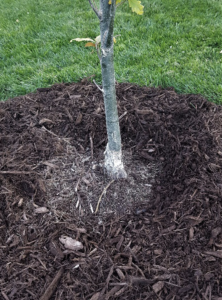You may be familiar with the program formerly referred to as “Ash GAP Removal and…
Care for trees before the freeze!
 As we all prepare our homes and gardens for winter, Denver’s Office of the City Forester urges residents to think about the trees and how to keep our urban canopy healthy during its dormant season. And if the leaves are still falling as you’re reading this, don’t forget to grab a rake, gather them up and compost them in paper bags to keep them out of landfills.
As we all prepare our homes and gardens for winter, Denver’s Office of the City Forester urges residents to think about the trees and how to keep our urban canopy healthy during its dormant season. And if the leaves are still falling as you’re reading this, don’t forget to grab a rake, gather them up and compost them in paper bags to keep them out of landfills.
Yes, trees are resilient. But we can help them along by taking a few key steps to winterize them, so they stay healthier year-round. Below are some simple tips, along with links to additional information, to make winter a wonderland for our urban canopy.
WINTER IS COMING
Get the most out of your irrigation system before it takes its well-earned seasonal hiatus. If you’re not winterizing the system yourself, contact your local landscape company now to get on their schedule before freezing weather sets in. But first, remember to get your trees watered and mulched prior to shutting off the system.
TOO MU(L)CH IS NEVER ENOUGH!
Applying mulch around the tree before it settles in for its winter’s nap is a good idea. A mulch ring around your tree holds moisture in and protects against temperature extremes. It decomposes and adds nutrients to the soil, too. We recommend learning the right way to mulch before getting started.
Ever hear of a mulch volcano? Piling mulch too high around the base of the tree keeps oxygen out, and can be deadly. Keep your mulch ring at least 6 inches away from the bark of the tree. 
Vertical mulching is a modern method that also improves soil conditions and allows for deeper water penetration. Vertical mulching removes columns of poor-quality soil around the tree, vertically, and then fills those columns with compost. Learn more about general tree care tips, including mulch.
Bark on the southern/southwestern face of your trees is subject to a condition called sun scald. To avoid this, you can wrap your tree’s trunk using materials like butcher paper, it’s waterproof and removes/absorbs some of the energy that the sun produces. A good rule of thumb is to install tree wrap around Thanksgiving and remove it around Easter.
WINTER NUTRITION TIPS
Remember: dormant doesn’t mean dead, so feeding and watering trees during this season can help them spring back into action in the next. It’s also wise to mow/mulch some of your tree leaves back into the turf to ensure the nutrients are making their way back to nature.
But when it’s 40 degrees or warmer – which is seen a lot during Denver winter – your tree still needs water, and snowfall just isn’t enough. So learn how to water trees in winter and make a plan to stay on top of it. Your “buds” will thank you in the spring.
WINTER PRUNING
Would you be surprised to learn that winter is a good time to prune? Well, put on your parka because certain trees, including American elm and fruit trees in the rose family should only be pruned while dormant to reduce the spread of disease.
If you are pruning something you can’t reach from the ground, it’s advised that you hire a tree care professional since they use specialized equipment and have training and expertise. In the City of Denver, tree contractors are required to be licensed and insured, and Denver has a list of licensed tree contractors for your convenience.
Learn more about watering, fertilization and protecting your trees with these frequently asked questions of winter tree care and give your trees a chance to thrive this season.
As always, if you need more information, please contact Denver’s Office of the City Forester at forestry@denvergov.org or 720-913-0651.
